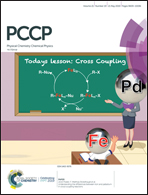Impact of fluorination on the photophysics of the flavin chromophore: a quantum chemical perspective†
Abstract
10-Methylisoalloxazine (MIA) and its mono-fluorinated derivatives (6-9F-MIA) were investigated by means of quantum chemistry, looking into the influence of fluorination on fluorescence, absorption and inter-system crossing (ISC). A maximized fluorescence quantum yield (ΦFl) of this chromophore is desirable for application as a potential fluorescence marker in biodiagnostics/photobiological studies. An enhanced triplet quantum yield ΦT on the other hand may open a perspective for photodynamic therapies (PDT) in cancer treatment. Determination of equilibrium geometries was carried out employing (time-dependent) Kohn–Sham density functional theory and electronic properties were obtained using a combined density functional theory and multi-reference configuration interaction (DFT/MRCI) method. In the gas phase, El-Sayed-favored 1(ππ*) ![[radiolysis arrow - arrow with voltage kink]](https://www.rsc.org/images/entities/char_e116.gif) 3(nπ*)-ISC enables population transfer to the triplet domain on a timescale of 109 s−1, i.e. significantly faster than fluorescence (kFl ≈ 107 s−1). Two different models were applied to investigate the influence of aqueous medium on absorption and relaxation: the implicit solvation model A is the well-established conductor-like screening model (COSMO) and hybrid model B combines quantum mechanical micro-hydration and conductor-like screening. A polar, protic environment leads to a significant blue-shift of the nπ* potentials, slowing down the ISC process to 107–108 s−1, now enabled by vibronic spin–orbit coupling. Simple principles are derived that demonstrate the effect of fluorination at different positions on the spectroscopic properties. These principles can be utilized with respect to multiply fluorinated derivatives and even further substitution to enlarge effects on the population decay and quantum yields.
3(nπ*)-ISC enables population transfer to the triplet domain on a timescale of 109 s−1, i.e. significantly faster than fluorescence (kFl ≈ 107 s−1). Two different models were applied to investigate the influence of aqueous medium on absorption and relaxation: the implicit solvation model A is the well-established conductor-like screening model (COSMO) and hybrid model B combines quantum mechanical micro-hydration and conductor-like screening. A polar, protic environment leads to a significant blue-shift of the nπ* potentials, slowing down the ISC process to 107–108 s−1, now enabled by vibronic spin–orbit coupling. Simple principles are derived that demonstrate the effect of fluorination at different positions on the spectroscopic properties. These principles can be utilized with respect to multiply fluorinated derivatives and even further substitution to enlarge effects on the population decay and quantum yields.



 Please wait while we load your content...
Please wait while we load your content...